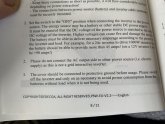You are using an out of date browser. It may not display this or other websites correctly.
You should upgrade or use an alternative browser.
You should upgrade or use an alternative browser.
Ground cable
- Thread starter Uk-solar
- Start date
The answer is, it depends. What does your set-up look like? Vehicle? House? If house: off grid or not?
Steve_S
Offgrid Cabineer, N.E. Ontario, Canada
Make, Model of Inverter ?
How are you configured ?
-- Diagram / photos ?
What is the application ?
-- EV, Residential, OFF / ON Grid, RV/Camper, Marine
What spark plug do I put in my motor but not mentioning the motor type, etc = useless question.
How are you configured ?
-- Diagram / photos ?
What is the application ?
-- EV, Residential, OFF / ON Grid, RV/Camper, Marine
What spark plug do I put in my motor but not mentioning the motor type, etc = useless question.
Where do I put the ground cable I got with my inverter??
nothing in instructions. Can’t find it anywhere online.
Reason for this is probably it’s too obvious and only a real dummy wouldn’t know
Cheers
Help us help you! Like others have said, provide more information:
- Make/model inverter (and whether it is an inverter or inverter charger)
- Link to product manual or schematic
- Quick description of your system/use-case
Pictures
Attachments
-
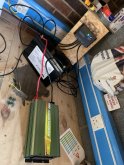 07916652-497F-453B-B389-C415D750E930.jpeg167.8 KB · Views: 19
07916652-497F-453B-B389-C415D750E930.jpeg167.8 KB · Views: 19 -
 F482762A-45ED-4086-9798-546C425CB206.jpeg130.8 KB · Views: 19
F482762A-45ED-4086-9798-546C425CB206.jpeg130.8 KB · Views: 19 -
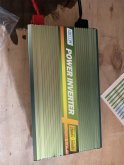 CD40851F-0C03-4DDA-9EFB-4A6E0357D828.jpeg125.3 KB · Views: 17
CD40851F-0C03-4DDA-9EFB-4A6E0357D828.jpeg125.3 KB · Views: 17 -
 FAD901BC-2E98-407D-96F4-BDC5719BCE70.jpeg167.8 KB · Views: 16
FAD901BC-2E98-407D-96F4-BDC5719BCE70.jpeg167.8 KB · Views: 16 -
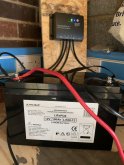 C865FAC1-BD30-4642-B7AD-9E30A48F436A.jpeg130.8 KB · Views: 17
C865FAC1-BD30-4642-B7AD-9E30A48F436A.jpeg130.8 KB · Views: 17 -
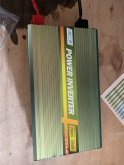 A7D82412-F66C-4627-BDFF-1D857AC7ACAC.jpeg125.3 KB · Views: 15
A7D82412-F66C-4627-BDFF-1D857AC7ACAC.jpeg125.3 KB · Views: 15
Obviously it would be ideal to follow the directions in your product manual or the manufacturers reccomendations, or get advice from a qualified expert (which I am most assuredly not).
There is no excuse for your manual not explaining how to properly ground your system, safety should be dummy proof!
So to be clear, your saying that your inverter came with a ground wire (green wire(?)), but manual doesn't tell you what to do with it? Is there an obvious place on the inverter to attach this ground?
My vague understanding, and again, my input shouldn't even be taken with half a grain of salt, is that most inverters internally ground the AC side to the metal inverter body, then the metal chassis should get bonded to the chassis/frame in a vehicle or boat, or to earth ground in a building.
I hope that some one more knowledgeable than me can come along and clarify or confirm what I've said. In the absence of that, here is a relevant section of the Samlex inverter manual (not your inverter but maybe the principle is the same).
There is no excuse for your manual not explaining how to properly ground your system, safety should be dummy proof!
So to be clear, your saying that your inverter came with a ground wire (green wire(?)), but manual doesn't tell you what to do with it? Is there an obvious place on the inverter to attach this ground?
My vague understanding, and again, my input shouldn't even be taken with half a grain of salt, is that most inverters internally ground the AC side to the metal inverter body, then the metal chassis should get bonded to the chassis/frame in a vehicle or boat, or to earth ground in a building.
I hope that some one more knowledgeable than me can come along and clarify or confirm what I've said. In the absence of that, here is a relevant section of the Samlex inverter manual (not your inverter but maybe the principle is the same).
Neutral to Chassis Ground Bonding
Neutral “N” (16, Fig 6.1) is bonded to the metal chassis of the inverter through a loop of wire connecting the “N” terminal on the Line side of the GFCI to the chassis of the inverter.
8.7 GROUNDING TO EARTH OR TO OTHER DESIGNATED GROUND
For safety, ground the metal chassis of the inverter to the Earth Ground or to the other designated ground (For example, in a mobile RV, the metal frame of the RV is normally designated as the negative DC ground). An equipment grounding Lug (7, Fig 6.1) has been provided for grounding the metal chassis of the inverter to the appropriate ground.
When using the inverter in a building, connect a 10 mm2 or AWG #8 insulated stranded copper wire from the above equipment grounding lug to the Earth Ground connection (a connection that connects to the Ground Rod or to the water pipe or to another connec-tion that is solidly bonded to the Earth Ground ). The connections must be tight against bare metal. Use star washers to penetrate paint and corrosion.
When using the inverter in a mobile RV, connect a 10 mm2 or AWG #8 insulated stranded copper wire from the above equipment grounding lug to the appropriate ground bus of the RV (usually the vehicle chassis or a dedicated DC ground bus). The connections must be tight against bare metal. Use star washers to penetrate paint and corrosion.
Steve_S
Offgrid Cabineer, N.E. Ontario, Canada
This is a "Car Inverter" for all intents and purposes. As such the chassis of the inverter could also be it's Neutral too. There is no provision for a Bonding Lead which multi-modal inverters have (those that can be either vehicular or non-mobile residential). NEVER Confuse Ground & Neutral !!
These types of Inverters are not generally used in a fixed installation system.
AC has to be grounded to Earth and that would be done from the AC Panel and with the bonding wires throughout the AC wiring system.
DC has no ground, only Pos & Neg. Negative is often chassis in a vehicle as well, but that never touches "earth ground".
These types of Inverters are not generally used in a fixed installation system.
AC has to be grounded to Earth and that would be done from the AC Panel and with the bonding wires throughout the AC wiring system.
DC has no ground, only Pos & Neg. Negative is often chassis in a vehicle as well, but that never touches "earth ground".
I would think that as long as you tie the wire to a grounded system in the garage, and there is no other wiring in the garage, this will work.
Attach the ground wire to the lug on the inverter chassis, and the other end to an earth rod, or a concrete rebar.
the issue arises if the neutral in the inverter contacts the grounding system outside the inverter.
these type inverters WILL shock you if connected improperly...
Attach the ground wire to the lug on the inverter chassis, and the other end to an earth rod, or a concrete rebar.
the issue arises if the neutral in the inverter contacts the grounding system outside the inverter.
these type inverters WILL shock you if connected improperly...
Steve_S
Offgrid Cabineer, N.E. Ontario, Canada
IN my "opinion" for what's it's worth, being that's it's free....Hi Steve. So would you Suggest I return this and get a more appropriate inverter?
Yes, if you can return it for a refund do so, and get a n appropriate inverter. I can see you bought this because it was a "Great Price & Seemed like Good Deal" nope, never heard that before... But yes, you can certainly get a good LF Inverter/Charger that will properly support the use of LiFePO4 batteries. In your bits of info, I saw no mention of charging aside from solar, always good to be able to charge without sunshine, Justin case.
As for budget, figure between $600 USD for Value Inverter/charger up to a couple grand if you want Tier-1 goodness with all the goodies (too uc for your app)
PS: Car Inverters are designed with Lead Acid Battery profiles in mind, so their cuts offs etc (if they have them) are for FLA.
What you just posted is another Car Inverter !
240VAC is North America split phase @ 60hz. BTW. WATCH FOR THAT ! If your UK, then that could be fugly !
210-230 VAC @ 50hz for europe right.
Victron 12 Volt Inverters | Victron Inverters
12v Inverter mains electricity from your 12v battery from 12v inverter stockist onBoardEnergy ready for immediate dispatch
This site has plenty of U.K. stock. Which of them would suit me best?
I have 400w of solar panels for this setup.
I appreciate the help. It must get a little annoying dealing with clueless people
John Frum
Tell me your problems
- Joined
- Nov 30, 2019
- Messages
- 15,230
Victron 12 Volt Inverters | Victron Inverters
12v Inverter mains electricity from your 12v battery from 12v inverter stockist onBoardEnergy ready for immediate dispatchwww.onboardenergydirect.co.uk
This site has plenty of U.K. stock. Which of them would suit me best?
I have 400w of solar panels for this setup.
I appreciate the help. It must get a little annoying dealing with clueless people
What is the largest single load in watts you wish to cover?
For me its the tea kettle which draws 1500 watts so I multiply by 1.2 to give me a bit of headroom which means I need an 1800 watt inverter.
Steve_S
Offgrid Cabineer, N.E. Ontario, Canada
Ohhh ,y, well I really like Samlex, what can I say.
We have different lines for Canada & US.
These are both families which would be good. Note Tier-1 = Not Cheap.
 www.samlex.com
www.samlex.com
 www.samlex.com
www.samlex.com
VICTRON is also Top Notch Tier-1 product, damned good stuff and very integrateable and growable too.
With 12VDC batteries, I would NOT consider going more than 3000W (which s 250A draw @ 12V/3kw) Then your into 24/48 V territory after that.
What would I suggest... It's you wallet ! and only you know how much you expect to draw from the system.
With One 12v/100AH (1.2kwh) battery & 400W of panel to charge, 1500W-2000W inverter/charger max. to be safe. Can't say really as the info you provided is pretty scant TBH. I could furtle around with all sorts of numbers but that would be meaningless.
We have different lines for Canada & US.
These are both families which would be good. Note Tier-1 = Not Cheap.
Pure Sinewave Inverter-Charger PSC-series Archives - Samlex
 www.samlex.com
www.samlex.com
Pure Sinewave Inverter-C/W Transfer Switch Archives - Samlex
 www.samlex.com
www.samlex.com
VICTRON is also Top Notch Tier-1 product, damned good stuff and very integrateable and growable too.
With 12VDC batteries, I would NOT consider going more than 3000W (which s 250A draw @ 12V/3kw) Then your into 24/48 V territory after that.
What would I suggest... It's you wallet ! and only you know how much you expect to draw from the system.
With One 12v/100AH (1.2kwh) battery & 400W of panel to charge, 1500W-2000W inverter/charger max. to be safe. Can't say really as the info you provided is pretty scant TBH. I could furtle around with all sorts of numbers but that would be meaningless.
I’ve still not got around to getting this sorted.I would think that as long as you tie the wire to a grounded system in the garage, and there is no other wiring in the garage, this will work.
Attach the ground wire to the lug on the inverter chassis, and the other end to an earth rod, or a concrete rebar.
the issue arises if the neutral in the inverter contacts the grounding system outside the inverter.
these type inverters WILL shock you if connected improperly...
So if I purchase an Earth rod and just attach it to that I should be ok?
Attachments
If you plug cords I to the inverter, and you attach the ground lug on the inverter body to a ground rod, you shouldnt get shocked.I’ve still not got around to getting this sorted.
So if I purchase an Earth rod and just attach it to that I should be ok?
Do NOT attach this type inverter to a breaker panel that is neutral bonded to ground.
Before doing anything, figure out what type of ground network you have. Since you're in the UK, you might have one of several. Don't randomly connect things to ground because you think 'well, ground is ground'. It's not, and your power company will have a stern talking with you if you do this. If your garage is off grid, and this is a 'floating' set-up where you don't have any earthing to begin with, you need to provide your own or live without it. It's not enough to slam in a ground rod and call it a day - you need to build a TT/TN whatever equivalent earthing for your 'independent' system, and there are requirements (such as impedance) that you need to keep in mind - never mind safety: do you add ground fault detection. If you live without it, you also carry the risks when something goes wrong.
I’m out of my depth with all this. I watched the video and thought this is fool proof! Obviously not as hear I am ?
Can anybody from England recommend a decent budget inverter for me to use with what I have?
I know this may seem very lazy of me but trust me I have been trying to learn myself and the bottom line of it is me and electrics just don’t mix!
Any help would be most appreciated for a dummy in need!
Can anybody from England recommend a decent budget inverter for me to use with what I have?
I know this may seem very lazy of me but trust me I have been trying to learn myself and the bottom line of it is me and electrics just don’t mix!
Any help would be most appreciated for a dummy in need!
At this point, I would actually recommend you either get a local electrician to have a look and give some recommendations, or you skip the inverter and do everything low voltage (assuming you need lighting only, not sure what you actually try to power).
At this point, I would actually recommend you either get a local electrician to have a look and give some recommendations, or you skip the inverter and do everything low voltage (assuming you need lighting only, not sure what you actually try to power).
It is mainly for lights in the garage. All my power tools are battery powered so it would have been used to charge batteries every now and then.
I will see if any electricians are working with what’s going on in the world.
Make your lights low voltage LED and then use a simple, small inverter to charge your tool batteries. You can probably get away with using an automotive inverter (like the ones you plug into the cigarette lighter thing) as long as you stay with a 12V system (like in your pictures).
Similar threads
- Replies
- 33
- Views
- 1K
- Replies
- 24
- Views
- 1K
- Replies
- 14
- Views
- 364
- Replies
- 36
- Views
- 900
- Replies
- 8
- Views
- 339



